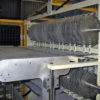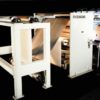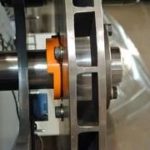In 1950, Lou Matthews’ son joined Maxson. A freshly minted mechanical engineer from the University of Rhode Island, Merton L. (“Mert”) Matthews quickly headed up Maxson’s design group. By the end of the decade, he had been awarded three patents relating to designs that increased the productivity of delivery and stacking systems.
In 1959, Julian Maxson died and was succeeded by his wife, Kathleen. As Vice President, Lou Matthews assumed responsibility for the Company’s operations aided by his long time partner, Joe Clancy.
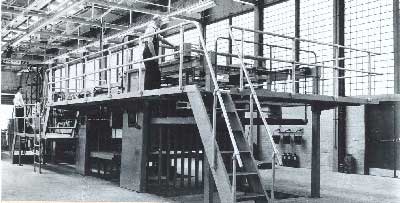
Maxson Dual Delivery & Stacking System
Because of Maxson’s reputation for innovation, service and value, other machinery manufacturers sought to partner with Maxson in offering sheeting lines to various industries. In board mills, Langston and Maxson formed a successful association selling mill duty dual knife rotary cutters and high production, continuous delivery lay boys. In the phenolic, melamine and impregnated glass cloth industries, Egan and Maxson worked together to provide inline sheeting systems for up to 20 foot long sheets. As a result of this diversification into new markets, Maxson prospered.
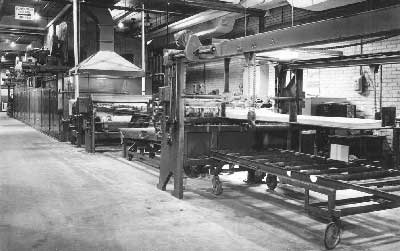
By the mid 1960’s, Maxson had been using the motto, “There’s always a touch of tomorrow in the MAMCO machines of today” for more than twenty years and doubled the size of its manufacturing facilities. Around the same time, the market began to favor sourcing a complete line from a single manufacturer, rather than integrating various makes of components to form a sheeter. This trend prompted Maxson to develop its own cutter.
Because of Maxson’s long experience integrating their delivery and stacking systems with other cutter manufacturers, Maxson engineers were able to address inadequacies in existing stationary bed knife design when developing their cutter. In 1967, Maxson installed its first cutter in the market place. Maxson’s advanced stationary bed knife cutter combined with its superior delivery and lay boy were well received.
The year 1970 brought stewardship changes as the childless Kathleen A. Maxson passed on. In an agreement arranged prior to Julian Maxson’s death, control of Maxson passed to Lou Matthews and Joe Clancy.
Louis L. Matthews’ tenure as President lasted no more than a fortnight, as he succumbed to a heart attack. Spanning over 50 years of service, Lou Matthews had patented 15 designs improving the cutting, delivery and stacking of sheeted stock. As the third employee of what became Maxson Automatic Machinery, he had participated in the evolution of an engineering firm to a manufacturer of full sheeting lines.


